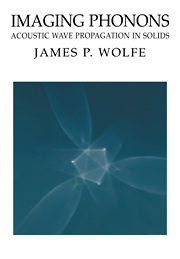Book contents
- Frontmatter
- Contents
- Preface
- Prologue – Anisotropic heat flow in crystals
- 1 Ballistic heat pulses and phonon imaging – A first look
- 2 Phonon focusing
- 3 Generation and detection of phonons – Experimental aspects
- 4 Focusing in cubic crystals
- 5 Acoustic symmetry and piezoelectricity
- 6 Lattice dynamics
- 7 Imaging of dispersive phonons
- 8 Phonon dynamics
- 9 Bulk scattering of phonons – Experiments
- 10 Quasidiffusion and the phonon source
- 11 Phonon scattering at interfaces
- 12 Refraction and reflection at solid/solid interfaces – Experiment
- 13 Imaging ultrasound in solids
- 14 Imaging surface acoustic waves
- 15 Interactions of ballistic phonons with electrons
- Appendix I Algebraic solution to the wave equation
- Appendix II Abbreviated tensor notation and group velocity
- Appendix III Survey of phonon focusing in cubic crystals
- Index
14 - Imaging surface acoustic waves
Published online by Cambridge University Press: 24 March 2010
- Frontmatter
- Contents
- Preface
- Prologue – Anisotropic heat flow in crystals
- 1 Ballistic heat pulses and phonon imaging – A first look
- 2 Phonon focusing
- 3 Generation and detection of phonons – Experimental aspects
- 4 Focusing in cubic crystals
- 5 Acoustic symmetry and piezoelectricity
- 6 Lattice dynamics
- 7 Imaging of dispersive phonons
- 8 Phonon dynamics
- 9 Bulk scattering of phonons – Experiments
- 10 Quasidiffusion and the phonon source
- 11 Phonon scattering at interfaces
- 12 Refraction and reflection at solid/solid interfaces – Experiment
- 13 Imaging ultrasound in solids
- 14 Imaging surface acoustic waves
- 15 Interactions of ballistic phonons with electrons
- Appendix I Algebraic solution to the wave equation
- Appendix II Abbreviated tensor notation and group velocity
- Appendix III Survey of phonon focusing in cubic crystals
- Index
Summary
Context
With few exceptions this book has concerned itself with the propagation of vibrational waves in the bulk of a crystal. As indicated in Section B of Chapter 12, there are also vibrational modes associated with the surface of the medium. They are known as Rayleigh surface waves (RSWs) and pseudo–surface waves (PSWs). As with bulk waves, the velocities of these surface waves depend on the propagation direction, so one might reasonably expect phonon-focusing effects. Indeed, Tamura and Honjo and Camley and Maradudin have predicted phonon-focusing patterns for Rayleigh waves in a variety of media. An example of the latter results is shown in Figure 1: (a) is the slowness curve for Rayleigh waves on the (111) surface of Ge and (b) shows the corresponding singular directions of energy flux emanating from a point source in this plane. Phonon caustics arise from the zero-curvature regions of the slowness surface, just as discussed with bulk waves in Figure 8 of Chapter 2.
Unfortunately, high-frequency surface phonons are likely to have much shorter mean free paths than bulk phonons, due to the sensitivity of these waves to surface irregularities. The scattering of surface phonons from such defects, plus the potentially huge background of scattered bulk phonons, makes it extremely difficult to observe the ballistic propagation and phonon focusing of surface phonons. A recent study by Höss and Kinder, however, has reported experimental evidence for the focusing of surface phonons on a laser-annealed Si surface.
- Type
- Chapter
- Information
- Imaging PhononsAcoustic Wave Propagation in Solids, pp. 355 - 378Publisher: Cambridge University PressPrint publication year: 1998



